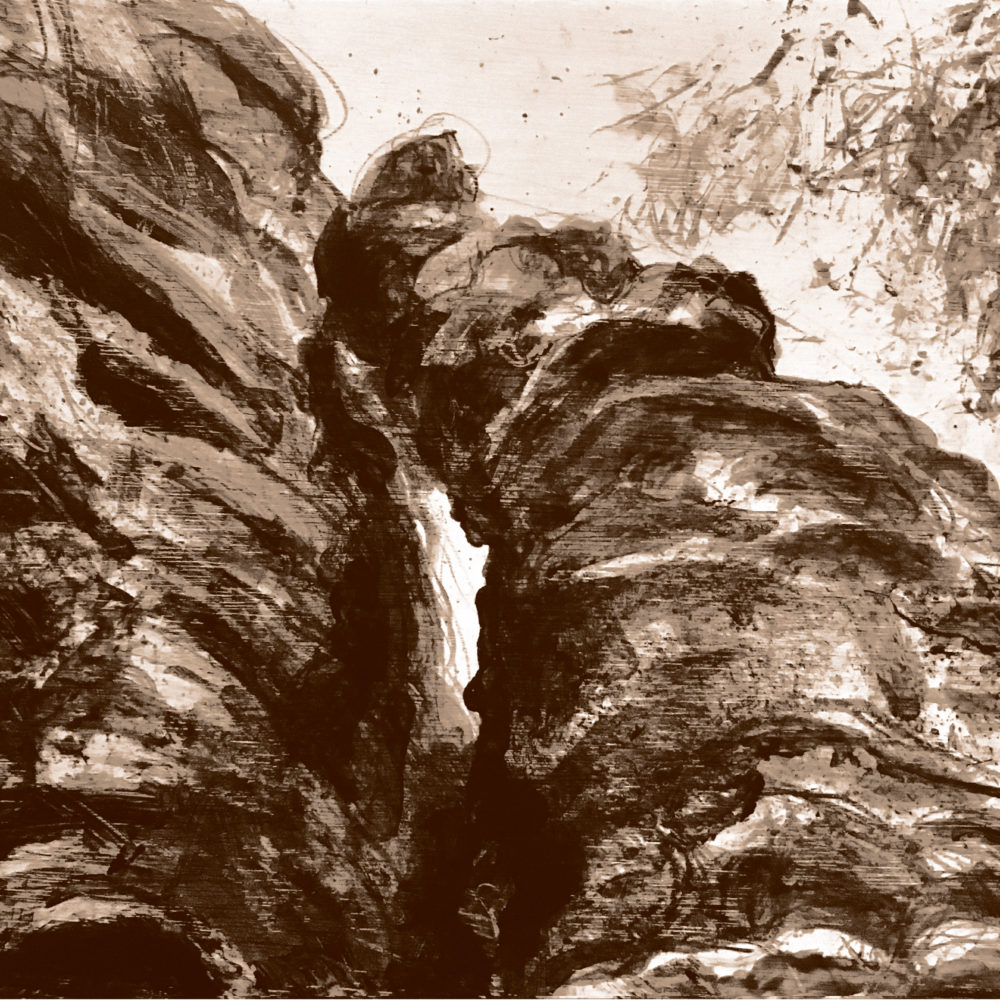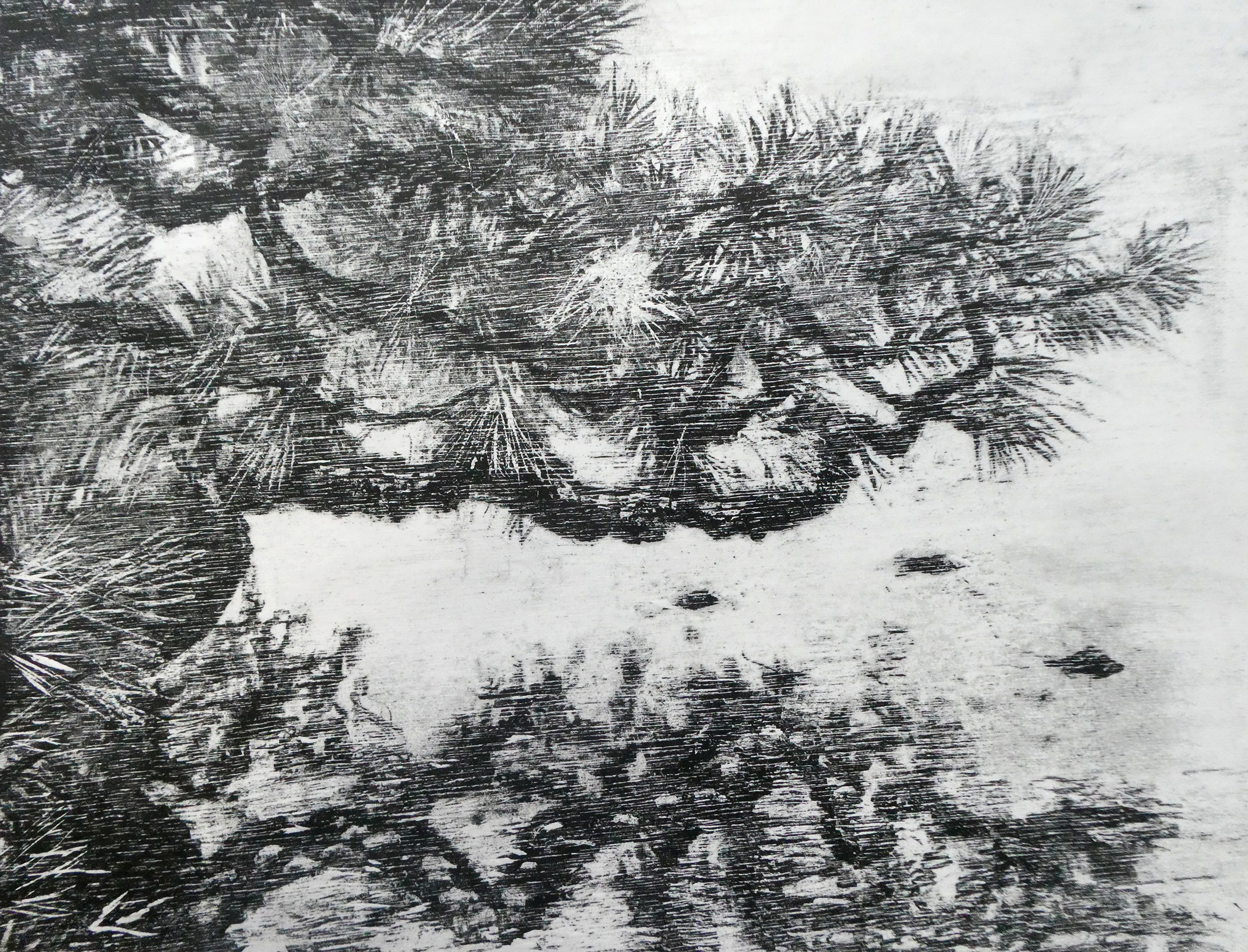
Elemental: Sam Sosnowski
Shel Sweeney explores the art of mokulito with NSW artist Sam Sosnowski.
24 June, 2019
In Exhibitions,
Printmaking, Q&A
Printmaker and artist Sam Sosnowski is no stranger to the idea of a quiet sense of harmony, indeed his Impression of Japan exhibition explore mindful reflections on Japanese culture. Now Sosnowski has turned his attention to the earth, waiting in stillness, aware, listening, slowly paying attention to the interplay of rock, plant, water and light. Sosnowski’s latest collection is a series of mokulito prints that conveys a deep exchange with nature that leave viewers feeling as though they have spent hours in the restorative presence of the earth at its most elemental.
Which artists have led and are leading the way with mokulito printing?
SS: Ozaku Seishi invented Mokulito the 1970s in Japan. He taught a number of Japanese artists who use mokulito in really abstract ways. The method was adopted by Polish artist Josef Budka and his daughter Ewa Budka. Her work is intuitive and abstract. Professor Kuniko Satake from Tokyo brought mokulito to Queensland in the early 2000s.
Australian mokulito artist, Barbie Kjar, uses a drypoint style for her portrait work. Danielle Creenaune from Port Jackson Press uses stone lithography and combines it with mokulito.
So there is a fair amount of experimenting with and combining of mokulito and other techniques. There are so many styles and a variety of materials being used. Mokulito invites experimentation. I guess that is why I am drawn to it.
Was mokulito a difficult technique to master?
SS: I wouldn’t say I’ve mastered it! It can be a rather frustrating process as there are quite a few elements which need to come together in just the right way for it all to work. When it does work, it’s worth it.
How important is the variety of plywood to a mokulito print?
SS: The type of plywood is essential. Softwood doesn’t work well – but some of the hardwoods are terrific! The only difficulty is local availability and the names one manufacturer might give to one type of ply may not be the same as another manufacturer – “structural ply” for instance. I managed to get a fantastic hardwood at the local hardware store under this name, but when I asked for it again, it was different.
Personally, I have found Pink Marine Ply suits my work, it’s not too grainy and easily available locally.
You play with ideas of nature and Animism, the belief that all things have a spirit or soul, in your work. Where does your interest in spirit and spirituality come from?
SS: I was raised until about 20 in a very religious Jewish household. My father came through the war after being in a couple of concentration camps. He lost his wife and two kids in the war and met my mum in a concentration camp. A lot of Jews lost their religion through the war, but my father stuck to it to some degree. He ran a hardware shop. He died in his early 60s, probably because he had such a hard time in the war. I was in my early twenties and had to grow up quickly.
Then I met my wife, Northern Rivers ceramicist, Jacqui. We have always had an interest in the land. It was pretty grass roots stuff. We bought some land in Blackwood in Victoria and were there for about 6 years. Then went back to Melbourne and sold there to move to a farm in Coffs Harbour. We were still really city people though. We were a bit too fast for the country and not fast enough for the city. We lived in Brisbane before coming here to Mullumbimby. We’ve had a fairly constant connection to nature. We’ve always been interested in country and land and the slower pace of things.
I suppose the interest in Animism came from a curiosity with spiritualism and formalised religion, to some extent. I feel there is a God and a spirituality in things. I’m not averse to believing that there is a life force around you. I think certain places have a certain spirituality, that there are sacred sites.
What drives your creativity?
SS: I love the process of creativity. Sometimes it’s a struggle to go through the process of refining an idea, and sometimes it comes easily. What do they say? “It’s the journey, savour it.”
I guess you start with the ‘aha’ moment, followed by “What was I thinking?” Then comes “This is crap, I am crap! What was I thinking?” Right through to “Actually, this is OK! I am awesome, this is awesome.”
Seeing your sketchbook, seeing sketches that are so raw and immediate, as well as things you’ve taken a little more time over, and then to look at the final prints, gives me more insight into your process. Can you talk a little of that?
SS: I think the creative process is elusive and its different for everyone. It’s also changeable. It’s different every time.
I wouldn’t call my process disciplined. Discipline is not the right word for me. Some people have the ability to create from seven in the morning, but I do it when I feel like it. Unlike my wife (ceramicist Jacqui) who is amazingly driven. She’ll go out at eight in the morning and she’ll still be there at four or five. When I was a graphic designer, I worked like that and would stay up until 3am if I had a deadline. Perhaps this is the difference between creativity and the business of creativity. It has taught me that you can switch it on and off.
Now I create when the urge kicks in. Having said that, if I have a show on, I’ll be out there every day.
For this series, our little caravan plays a role too. There’s a mobility with the caravan, and you stop and savour a place a little, be immersed in it. We call our caravan the tin tent. Here, in the studio, I get into a daily routing. Sometimes I need to freshen up the canvas, so we’ll jump in the caravan and go away for the week. There’s a farm at the back of Grafton that we go to called The Gorge. This was probably my first inspiration to get into rocks and water. It’s a beautiful spot.
How many pieces do you aim to have for an exhibition?
SS: For a solo show, roughly between 24 and 30. Right now, I’m probably hitting around 20 already.
I am my hardest critic. Every piece I do has to go that little bit further than the last piece, and in this way, I push myself. The last piece I did has brought the strongest reactions of the series to date, so I must be getting something right, I’m starting to hit the mark.
I like lots of things and different ideas and am not always sure what to follow. A sculptor/teacher I once had, John Davies, said it was the ideas that keep coming back and drive you crazy that are the ones you really should follow, that you need to resolve. As far as inspiration is concerned, that might be a photo I took six months ago, that stays in my interests in the back of my mind.
Rudolf Steiner said you should learn as many things as you can from lots of different places so that the base of your pyramid gets bigger and that when you do focus on something, all those bits come to play. Nothing is wasted, it’s all life experience and all those elements pull together when you are creating something new.
What’s the trickiest part of putting an exhibition together?
SS: Over and above the financial aspect of it, you get to the stage where you don’t want to put pieces in a joint show. You start working on themes because you feel like resolving something, then you end up with a body of work and you need to find a place that will hold that body of work.
There are definitely financial considerations, but there’s also considerations of whether or not you feel comfortable with the person (gallery space) that you’re going to have the show with. There must be some kind of empathy with the gallery and the space has to be right, the lighting must be right, the feeling has to be right. You shouldn’t grab the first place you come to, you need to consider whether or not it suits the work that you’ve produced.
Unless you hire a space and take it all on board yourself, there are a whole lot of influences, interests and considerations.
You also run mokulito workshops. What is it about teaching that you enjoy?
SS: Teaching is nice because it makes me think about what I do so I can then articulate that, and I find that really enjoyable. The more you give students, the more they give you back and you learn from them too. Students ask questions that I may not have thought about, and that makes me go and find out the answers, or they try something I hadn’t thought of trying.
You get as much back as you give. Sometimes what I’m teaching really lights someone up, and that is why I love teaching. You show someone five minutes of patience and that can set them up on their own creative path.
Teaching is totally unappreciated today, but it is one of the most powerful tools we’ve got. It has the ability to influence whole generations of people and the way they think.
What’s coming up for you?
SS: This collection of mokulito prints will be part of the upcoming Elemental exhibition, at the Northern Rivers Community Gallery.
Elemental, featuring Sam and Jacqui Sosnowski, is at Norther Rivers Community Gallery, 44 Cherry Street, Ballina, 4 July-2 August. Jacqui Sosnowski’s exploration of ceramics harks back to Greek and Roman Amphorae, echoes her Jewish history, and takes us into the subconscious.
Earth, Water, Fire and Air find expression and form in Jacqui’s ceramic pieces. Jacqui exposes her ceramic creations to Fire and Water through raku and Obvara firing, both processes that involve the rapid restriction of Air to the surface of the piece through the immersion in sawdust while red hot, then the submersion in water for swift cooling. The newly fired pots come alive as they are transformed by each Element. Each piece emerges bearing the energy of this process on its surface and revelaing something of the interplay of Earth, Water, Fire and Air.
Both Jacqui and Sam welcome the unexpected into their processes and the resulting ‘happy accidents’ make this exhibition so engaging.





